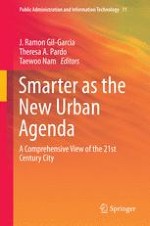2016 | OriginalPaper | Chapter
Toward a Methodological Approach to Assess Public Value in Smart Cities
Authors : Dr. Michele Osella, Dr. Enrico Ferro, Ms. Elisa Pautasso
Published in: Smarter as the New Urban Agenda
Publisher: Springer International Publishing
Activate our intelligent search to find suitable subject content or patents.
Select sections of text to find matching patents with Artificial Intelligence. powered by
Select sections of text to find additional relevant content using AI-assisted search. powered by
